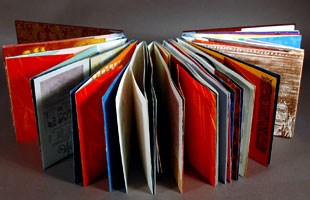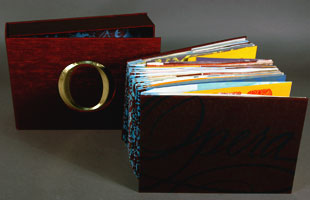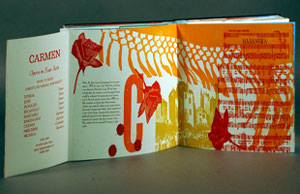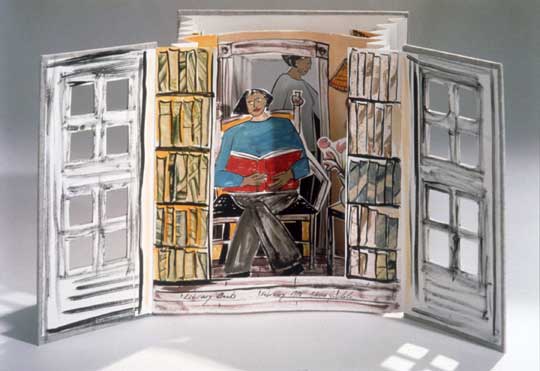| Literary Essences by Wendy Fernstrum |
| Literary Essences by Wendy Fernstrum
As the author states, Literary Essences plays with the idea of literature as an elixir- a "you are what you read" approach to wellness. This is a sensory, mind-body literary experience that amuses and tantalizes in its sense of its own valid purpose, and in its intricate and humorous design and creation. The artist explains that this is a step by step guide to the use of literary essences as natural health remedies for emotional and spiritual well-being. The 'book' consists of 26 vials of literary essences, each labeled with the title of a book and containing small discs of paper purportedly cut from the pages of the first editions of those books, along with a scent "that captures the precise and particular odor" that is representative of the emotional content of those works. "Each essence cures, alleviates, or engages certain feelings, symptoms, or conditions." An accompanying bound volume titled "Literary Essences-A Practical Overview" is a guide to how the essences should be used for best effect. The book also poses searching questions to enhance the reader's experience with each book. In addition, the guide offers a pseudo-scientific explanation of how the literary essences are extracted, distilled, infused. The guide issues a cautionary piece of advice as well: that "the essences not be used as are drugs or even herbal remedies, because literary essences are soul remedies." At the same time there is the suggestion that the essences can "facilitate remarkable changes in physical health." Examples of such effects are given. For example "someone taking "On Walden Pond" essence to treat a life of quiet desperation may feel an acute awareness of oppression before being able to live independently." By the same token, asking about Milan Kundera's "Identity"-"Do you feel a vague sense of panic over the thought that, essentially, you're no different than any other schmuck in the world?" Discussing Walt Whitman's "Leaves of Grass" the question is asked of the user "Do you believe life is randomly meaningless?" To be used in conjunction with the "Practical Overview" is a series of cards representing each title, identifying the "positive qualities" and the "patterns of imbalance" that each work might elicit.
Literary Essences is contained in a clam-shell box with a pair of tweezers for handling the scent-infused discs of paper.
This is a remarkable work in itself, combing literature, homeopathy, body-mind-spirit philosophies, and a great deal of tongue-in-cheek humor.
Literary Essences by Wendy Fernstrum (25 x 29 cm) published by Fernwerks Press in Minneapolis, MN
2000 in an edition of 25 copies signed by the author. The copy in the Herron School of Art and Design Artists' Books collection is number 15.
|
Artists' Books at the Herron
Wednesday, April 9, 2014
Wednesday, April 2, 2014
| Snow Bound in September : a Re-imagining by Laurie Whitehill Chong (2012) |
"Mortals wander, but Mountains are as Old Friends"
(from the Foreword)
Thursday, March 27, 2014
A Trip to the Opera awaits you when you open Jim Machacek's and Sibyl Rubottom's O is for Opera.
This accordion-bound book provides an alphabetical journey through some of the major operas and operatic features beginning with Aida and ending with the post-performance celebration, with Champagne and confetti on hand. Each chapter is illustrated and designed in minute detail with, for example, a giraffe and a fold-out pyramid accompanying Aida, part of the libretto of Madame Butterfly printed on gossamer-like paper reflecting the butterfly wings, the 'S' represented by a fold-out image of Sydney Opera House emerging from the page. Set Design is addressed with images from both front and back-stage where card doors open to reveal the layered design of an opera stage. Even the intermission is taken into consideration with 'I' at the Cafe Intermezzo. "The book is contained in a box lined with paper whose design is the work of Fortuny (Mariano Fortuny, 1871-1949, textile designer). The same fabric design becomes the accordion spine of the book." (Artist's note). On the box is a gold 'O' standing boldly proud of the surface. To even further authenticate and enhance the opera experience for the reader, a program and opera glasses (albeit made of card) are also provided. Included also is a boxed cd to accompany the book. This is both fun and informative and teems with creative detail throughout.
This accordion-bound book provides an alphabetical journey through some of the major operas and operatic features beginning with Aida and ending with the post-performance celebration, with Champagne and confetti on hand. Each chapter is illustrated and designed in minute detail with, for example, a giraffe and a fold-out pyramid accompanying Aida, part of the libretto of Madame Butterfly printed on gossamer-like paper reflecting the butterfly wings, the 'S' represented by a fold-out image of Sydney Opera House emerging from the page. Set Design is addressed with images from both front and back-stage where card doors open to reveal the layered design of an opera stage. Even the intermission is taken into consideration with 'I' at the Cafe Intermezzo. "The book is contained in a box lined with paper whose design is the work of Fortuny (Mariano Fortuny, 1871-1949, textile designer). The same fabric design becomes the accordion spine of the book." (Artist's note). On the box is a gold 'O' standing boldly proud of the surface. To even further authenticate and enhance the opera experience for the reader, a program and opera glasses (albeit made of card) are also provided. Included also is a boxed cd to accompany the book. This is both fun and informative and teems with creative detail throughout.
San
Diego, California: False Bay Editions, (False Bay Editions), 2006. Edition of
45 of which this is number 27, signed by authors.
9.4 x 6.75"; 90 pages. Accordion fold with pop outs and
multiple other movables. Letterpress printed on Velata paper using Bernhard
Modern type and images by photopolymer plates. Calligraphy design by Judythe
Siecke. Set page drawings by Stephen Hendrickson. In wine-colored cloth-covered
7.25 x 10 x 2.75" box.
 |
| O is for Opera (Image courtesy of Vamp and Tramp Booksellers) |
 |
| O is for Opera (Image courtesy of Vamp and Tramp Booksellers) |
 |
| O is for Opera (Image courtesy of Vamp and Tramp Booksellers) |
Monday, March 17, 2014
| Summer at the Beach by Stephanie Mahan Stigliano (2005)
Writing from the depths of a long winter it is therapeutic to discuss a book that calls to mind the distant balmy days of summer. In the Herron Collection nothing does this quite like Stephanie Mahan Stigliano's "Summer at the Beach" that draws on objects found on the beach which are used in the creation of a book about memory. Playful and poignant at the same time, and consisting of a box with a slotted lid and carved in low relief with collographs and hand-painted, the book contains 26 "pages" that are painted bottle caps, known as "coins", found on the beach with texts lining the insides of the coins and protected beneath sand-encrusted resin. The texts are brief statements, possibly a dissected poem, that could be interpreted to connect the sea, life, the ponderings of a beach-comber, or a creature of the shore. Examples are "Can my delicate shell protect me?", "I am as ruthless as a shark", "I drift away", "Sun-warmed water is above and the cold is below-two parts of my divided self", "I melt inside and dissolve in his arms", "I am chosen and float to the surface", "Out of control of my destiny, I am [a] jellyfish tossed by the waves". The coins of memory and contemplation are dropped through the slot in the box lid, rattling against each other as they fall. This is one in a series of "Memory Books" by the author using slotted boxes and bottle caps. Others include "City Sights and Sounds" (2004).
|
Wednesday, March 12, 2014
Insecta by Linda Broadfoot (Text by A. S. Byatt) : Published by Linda L. Broadfoot, 2005
 |
| Insecta by Linda Broadfoot (Image courtesy of Vamp & Tramp, Booksellers) |
One's first impression of this wonderful 'book' is of a custom-made Schmitt insect specimen box made from maple and poplar with brass hinges and clasp, and title label holder that states "Insecta". However, opening it reveals six bound portfolios each containing colour images of insect specimens veiled behind shimmering silk organza screens that lend texture to the illustrations and give the impression of movement and flight, imbuing the insect images with life. The six portfolios titled Lepidoptera I and II, Diptera Hymenoptera Odonata, Hemiptera, Coleoptera, and Neuroptera show butterflies, moths, wasps an ants, cicadas, firebugs, beetles, antlions, and owlflies, among others, in their vibrant glory, and are accompanied by A.S. Byatt's story, "Things Are Not What They Seem" bound separately, providing a magical guide to the 30 illustrations of the specimens.
In her artist's statement Linda Broadfoot says:
"In the spring of 2001, I began to borrow insect specimens from the Florida State Collection of Arthropods. Carefully transporting this delicate cargo to New York, I used the Polaroid 20 x 24 Studio to make large image transfers of my subjects. I was working with an alternative photography process—after the initial exposure, the image is transferred to watercolor paper, and then refined by hand to mute portions of its surface. The final piece is titled with the specimen's Latin name, in the tradition of ars botania. Selecting from more than 60 originals, I chose the work enclosed in this book to make small prints on fine art paper for these pages.
"Upon discovering in British author A.S. Byatt's Angels and Insects the mystic tale 'Things Are Not What They Seem,' I knew it was the ideal narrative frame for these strange and beautiful creatures. Her words are included here not only as a vital element but a numinous guide to viewing this Cabinet of Wonder. Such a tradition can be traced to the sixteenth and seventeenth centuries when European gentry compiled collections of oddities and exotic artifacts from the New World. These Wunderkammern were Cabinets of Curiosities to those who were bound to their parlors as the wonders of untamed lands flooded into their ports.
"Insecta is a modern-day Wunderkammer. Here, the reader may take an active part in the revelation of the cabinet's contents, a balance of the creations of both God and man—nature and art."
The colophon states that A. S. Byatt's text is printed on Hahnemuhl'e Biblio paper and the images are printed by the artist on Crane's Museo paper using Ultrachrome inks and are enclosed in silk organza pockets mounted on Hahnemuhle's Copperplate.
Insecta was published in a limited edition of 50 copies. The copy in the Herron School of Art & Design Library, IUPUI, is no. 27
Monday, March 3, 2014
Al-Mutanabbi
Street
On March 5th, 2007, a car bomb exploded on al-Mutanabbi Street near
the old quarter of Baghdad in Iraq. Named after the 10th century classical Iraqi poet Al-Mutanabbi,
the street was filled with bookstores and outdoor book stalls and was
considered to be the heart and soul of the Baghdad literary and intellectual
community. More than 30 people were killed and more than 100 wounded in the
explosion, and the street and its community were destroyed.
One response to the attack was the formation of another community,
this one of international artists and writers, who came together to produce a
collection of broadsheets, artists’ books, and writings expressing the broader artistic
community’s solidarity with that of Iraq. Instigated by a San Francisco
bookseller, Beau Beausoleil, artists were invited to submit broadsheets,
artists’ books and writings to commemorate this tragic event. This coalition of
contributing artists calls itself the Al-Mutanabbi
Street Starts Here Coalition. Since its formation the coalition has sought
to support and promote awareness of the enduring nature of the written word,
art, and freedom of expression. The attack on Al-Mutanabbi Street has been seen
as an assault on these basic principles, as well as on the artistic community
as a whole, and that the suffering of Al-Mutanabbi Street, its community, its
businesses, and what it represents in the wider cultural context, is shared by
the global cultural community. Each artist was requested to create 3 copies of
their response that would reflect both the strength
and fragility of books, but would also show the endurance of the ideas they
express. Here at the Herron Library we are fortunate to have, as part of
our permanent collection, three of the works created in response to the
bombing. A complete set of all the books will be donated to the Iraq National
Library in Baghdad. Another set will tour the world demonstrating the
universality of the artistic response. The Herron Library has been chosen as
one of the libraries that will co-curate and exhibit the entire collection of
over 250 books and broadsheets. This will take place in October, 2014.
On December 18, 2008, Iraqi Prime Minister Nouri
al-Maliki officially reopened Al-Mutanabbi Street.
In the Herron Art Library the following 3 artists’ books
are on permanent display.
 Memento
MementoBy Julie Chen
Berkeley [California]: Flying Fish Press, 2012. Number 12 of an edition of 50.
A custom-made copper case/locket (1.8125 x 2.375 x
0.75") by Christina Kemp houses on one side a miniature book (1.5 x 2.125
x 0.375", 56 pages) letterpress printed on Kitakata and opens on the other
side to reveal a triptych. The case/locket and a web strip (for wearing the
locket) are housed in cavities in a padded clamshell box (5.625 x 6.75 x
2.875") with title on the cover. The colophon slips into a groove in the
box's base. Materials: copper box: bookcloth; binder's board; satin;
plexiglass.
Julie Chen: "Memento is about the fragility of the book
and the power of reading. It includes a miniature book that is housed in a
metal locket that allows the reader to wear the book close to the body. The
simple act of carrying a book on one's person has diverse implications
depending on circumstance and place. The locket also houses a triptych that
contains a woven token commemorating Al-Mutanabbi Street in Iraq. The texts on
the woven strips are taken from the preambles to the constitutions of the
United States and Iraq. The image surrounding the token is of a booksellers
stall on Al-Mutanabbi Street prior to the bombing in 2007. While the
commemorative aspect of this piece is clear, the content of Memento addresses philosophical questions
about the nature of reading and information transfer in our own lives as well
as within the context of western culture in general. This edition is part of An
Inventory of Al-Mutanabbi Street."
Memory
of Al-Mutanabbi Street
by Christine Kermaire [Charleroi, Belgium : Christine Kermaire]
2012. Number 157 of an edition of 300.
Four rectangular pieces of tan paper folded into three over-lapping layers and attached at one end to a black and gray houndstooth print fabric and pasteboard cover. The book consists of the names
of people who were killed in the car bombing, inscribed around an endless screw
and pulled by a red thread. The graphics were inspired by the lintels of wood
carving “ham yo“) placed at the front of the houses to protect against “the
wrong spirits” (Asia).(Artist’s description)
Memory of Al-Mutanabbi Street
And a second title in Christine Kermaire’s “An Inventory of
Al-Mutanabbi Street” trilogy:
Future of Al-Mutanabbi Street
by Christine Kermaire
.jpg) |
| Future of Al-Mutanabbi Street |
Contains nine mounted miniature
printed books with marbled paper covers, each containing the same English
language text of a poetic passage by the Iraqi poet Al-Mutanabbi, and
bound in hounds- tooth silk-screened cloth.
Event
The Herron Art Library will host a reading on March 5th, 2014 (4-6 pm) to commemorate the bombing of
Al-Mutanabbi Street. The event is free and open to the public. These books and
a selection of broadsheets created in response to the bombing are on display.
Monday, February 24, 2014

Library Books
By Rebecca Goodale
Portland, Maine: Rebecca Goodale, 1998 (26.7 x 27.9 cm.) Ink and collage on paper.
Working in a library, as I do, there is an attraction to images that reflect that environment and depict the landscape that is familiar to any librarian, particularly when depicted from an unusual perspective. The attraction of Rebecca Goodale's "Library Books" is that it presents an almost voyeuristic view of a library from outside through its panelled windows. The front cover, bound in cloth, opens to reveal two women inside the library, card cut-outs lent depth and perspective by the book's tunnel concertina design. Among a naive impression of library shelves, one woman is seated on a chair reading a book entitled "Paris". The other woman, standing, can be seen through a door frame behind her browsing the shelves. A vase of tulips sits on a small side-table behind which a standard lamp stands in the corner. Through the library's 'rear' window, a third woman is visible, sitting in an armchair with a book open on her lap. The quiet library scene is bright and colorful, the open windows inviting.
Subscribe to:
Posts (Atom)
